Understanding Ductless Air Conditioners & Their Benefits
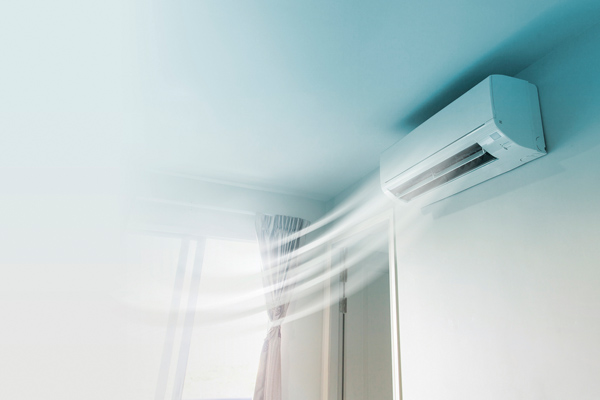
If you’re exploring air conditioning options that maximize flexibility and efficiency without needing complex installations, consider ductless air conditioners, commonly known as mini-split systems. At McAllister Energy, our commitment to elevating indoor comfort shines through our expert installation, repair, and ongoing care of ductless air conditioning units.
This article delves into how do ductless air conditioners work, emphasizing their key features and advantages as a contemporary, energy-efficient HVAC option. Whether you’re thinking about switching to a zoned cooling approach or just interested in learning more about the benefits of ductless systems, this provides useful information for enhancing comfort in your home or office.
Upgrade to Ductless Comfort with McAllister Energy: Stay cool and save energy with a ductless mini-split system. Call now to explore your cooling options.
The Mechanics of Ductless Air Conditioning Systems
Contents
- 1 The Mechanics of Ductless Air Conditioning Systems
- 2 Defining a Ductless Air Conditioner
- 3 Essential Elements of a Ductless AC System
- 4 The Functionality of Ductless Air Conditioners
- 5 Advantages of Ductless Cooling Systems
- 6 Is a Ductless Air Conditioner Ideal for Your Home?
- 7 Expert Ductless HVAC Installation & Maintenance With McAllister Energy
- 8 FAQs About the Functionality of Ductless Air Conditioners
- 8.1 Can Ductless Air Conditioning Units Provide Both Heating and Cooling?
- 8.2 How Many Rooms Can One Ductless System Cool?
- 8.3 Do Ductless Air Conditioners Offer Better Energy Efficiency Compared to Central AC?
- 8.4 How Long is the Lifespan of Ductless A/C Systems?
- 8.5 Can Ductless Cooling Systems Enhance Indoor Air Quality?
- 9 Conclusion
- 10 Contact McAllister Energy for Premier HVAC Services
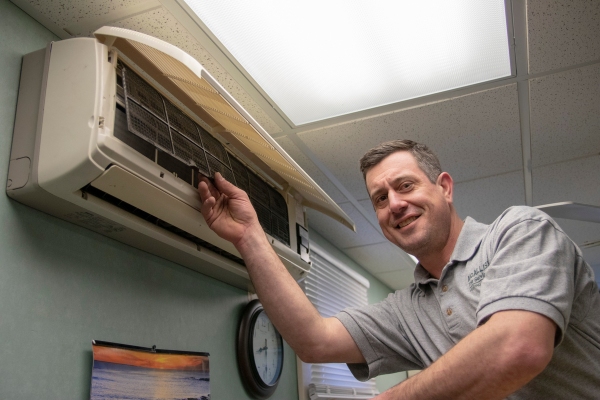
With an understanding of the benefits and services McAllister Energy provides for ductless air conditioning, let’s explore the mechanics behind these systems. Adopting a ductless system can significantly improve your cooling efficiency and comfort; this section offers a straightforward guide to how these systems operate.
Enhance Your Cooling Experience: Experience the advantages of ductless air conditioning with McAllister Energy—reach out to us now!
Defining a Ductless Air Conditioner
A ductless air conditioner, often called a mini-split system, is engineered to offer heating and cooling solutions without using ductwork. Unlike conventional central air systems that depend on an extensive network of ducts to circulate air across a building, this system stands out for its simplicity and efficiency.
Rather, ductless systems employ separate air handlers positioned in each room or zone, providing efficient and direct air conditioning. This arrangement is especially advantageous for buildings without pre-existing ductwork. It is also ideal for expansions, apartments, garages, and particular rooms that need separate temperature settings, presenting a flexible and minimally invasive installation method.
Essential Elements of a Ductless AC System
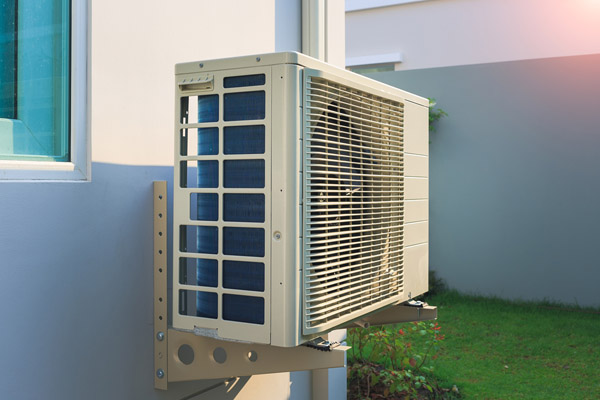
Grasping the components of a ductless air conditioning system enhances understanding of its efficiency and adaptability. The system consists of:
- Outdoor Condenser Unit: This vital part of the cooling process houses the compressor and refrigerant. It is compact yet designed to operate more quietly than conventional units.
- Indoor Air Handlers: These are strategically installed in various rooms to distribute cooled air effectively. They can be mounted on ceilings, walls, or floors and are crafted to integrate seamlessly with your home’s aesthetics.
- Refrigerant Lines & Electrical Wiring: These components bridge the outdoor and indoor units, transferring coolant and electricity essential for the system’s function. This configuration promotes a clean and inconspicuous look.
- Remote or Smart Controls: These devices enhance convenience by allowing independent temperature adjustments in each zone. More sophisticated units also feature Wi-Fi connectivity, enabling integration with other smart home technologies for improved control and energy efficiency.
Tailor Your Comfort: Secure professional installation and maintenance for your ductless system—contact McAllister Energy today!
The Functionality of Ductless Air Conditioners
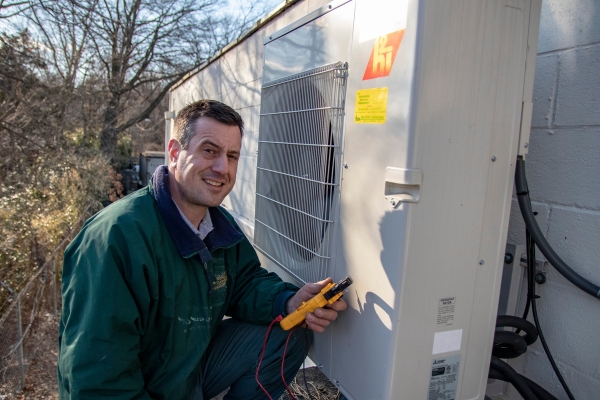
Grasping how ductless air conditioners operate is crucial for recognizing their efficiency and adaptability across various environments. Here’s a detailed explanation of their operation:
Step 1: Cooling the Refrigerant in the Outdoor Unit
The compressor in the outdoor unit pressurizes and cools the refrigerant, setting the stage for it to extract heat from inside your home.
Step 2: Transporting Refrigerant to the Indoor Unit
The chilled refrigerant moves to the indoor unit via insulated pipes, which preserve its low temperature throughout the journey.
Step 3: Heat Extraction and Air Cooling
In the indoor unit, the cold refrigerant extracts heat from the room’s air. Once the heat is absorbed, the unit cools the air and sends it back into the space.
Step 4: Expelling Heat Outside
The heat gathered from the indoor air is carried back to the refrigerant and transported to the outdoor unit, where it is expelled outdoors.
Step 5: Consistent Temperature Control
The ductless air conditioner constantly adjusts to maintain the desired indoor temperature. It modifies the refrigerant’s flow and temperature to ensure a steady, comfortable indoor atmosphere, thus maximizing energy efficiency and effectiveness.
Move Beyond Inefficient Cooling: Allow McAllister Energy to guide you to the ideal ductless solution for your home—book a consultation now!
Advantages of Ductless Cooling Systems
Ductless cooling systems are increasingly favored in residential and commercial settings due to their distinct benefits over traditional HVAC systems. Key advantages include:
Energy Efficiency
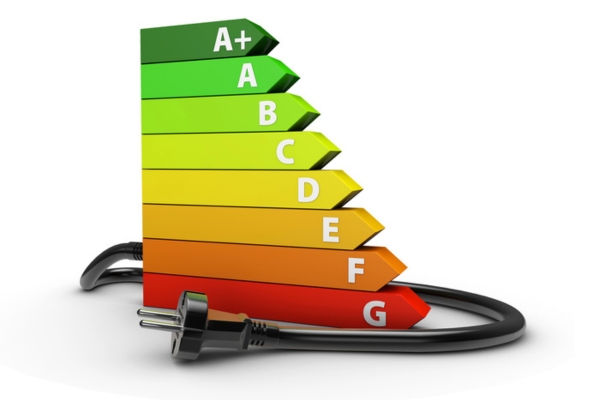
Ductless models excel in efficiency primarily because they eliminate the need for ductwork, which can cause significant energy losses in standard systems. Additionally, inverter technology allows these systems to scale their cooling output to match the current demand, minimizing energy wastage and reducing utility costs.
Optimal Comfort in Every Space: Zoned cooling solutions from McAllister Energy ensure your home stays comfortable all year—contact us today!
Zoned Cooling for Enhanced Comfort
A standout feature of ductless systems is their ability to provide zoned cooling. This functionality lets you adjust the temperature in specific rooms or zones, ensuring uniform comfort without the hot or cold spots common in various parts of a home or office. Particularly advantageous in multi-level homes, newly added spaces, and apartments, zoned cooling caters to the diverse temperature needs of different areas efficiently.
Simplified Ductless Installation with Minimal Disruption
The installation process for ductless air conditioners is uncomplicated and swift. Generally, just a tiny wall hole is needed to link the indoor and outdoor units. This straightforward approach results in a much faster setup than the lengthy and disruptive installation required for traditional ductwork in central air systems.
Enhanced Indoor Air Quality
Ductless air conditioning systems have sophisticated filtration technologies that boost indoor air quality by removing allergens, dust, and other airborne pollutants. Moreover, the absence of ductwork prevents the accumulation of dust, mold, and debris, inherently maintaining cleaner air within indoor environments over time.
Experience Quiet, Efficient Cooling with a Ductless System: Have McAllister Energy install the ideal solution for your home—contact us today!
Silent Functioning
The indoor and outdoor ductless systems’ components are engineered for quiet operation. This makes them particularly suitable for areas where noise is an issue, such as bedrooms, home offices, and spaces where a tranquil environment is essential. This quiet performance contrasts sharply with traditional HVAC systems, which are frequently louder and more disruptive.
Is a Ductless Air Conditioner Ideal for Your Home?

Determining if a ductless air conditioner suits your needs involves various considerations. This system is perfect for homeowners who want zoned heating and cooling without major construction, providing an economical option particularly for extensions or older properties without pre-installed ductwork. These systems are also preferred for their ability to reduce energy expenses and enhance overall efficiency.
Nonetheless, before deciding on a ductless system, it’s important to weigh the initial installation expenses, which are more than those of window units but typically less than the costs of retrofitting an existing central air system. Also, the careful positioning of indoor air handlers is vital to ensure maximum cooling efficiency.
Simplifying Ductless Air Conditioning: McAllister Energy has you covered from installation to maintenance—reach out to us today!
Expert Ductless HVAC Installation & Maintenance With McAllister Energy
Opting for McAllister Energy for your ductless HVAC installation guarantees a customized solution tailored to your home’s specific cooling requirements. Our skilled technicians are adept at designing ductless setups that perfectly complement the distinct features of your space. We provide professional installation, meticulous maintenance, and prompt repairs to ensure your system operates optimally.
Not sure if a ductless system is right for your home? Book a consultation with McAllister Energy today, and let us assess your needs to propose the most effective cooling solution for you.
FAQs About the Functionality of Ductless Air Conditioners

Can Ductless Air Conditioning Units Provide Both Heating and Cooling?
Absolutely! Numerous ductless air conditioners operate as heat pumps, enabling them to cool your space in the summer and warm it in the winter. This dual capability positions them as a superb all-season climate control option, eliminating the necessity for distinct heating and cooling units and consequently decreasing energy expenses.
How Many Rooms Can One Ductless System Cool?
A single outdoor unit can manage multiple indoor air handlers, contingent on the system’s capacity. Certain models are capable of cooling and heating as many as eight rooms efficiently, enabling homeowners to establish tailored temperature zones throughout their property. This adaptability renders ductless systems perfect for multi-level homes, extensions, or areas with diverse comfort requirements.
Do Ductless Air Conditioners Offer Better Energy Efficiency Compared to Central AC?
Indeed, ductless systems typically surpass traditional central air conditioners in energy efficiency. They prevent the energy losses associated with ductwork, representing up to 30% of energy wastage in ducted systems. Moreover, their inverter-driven compressors modulate the cooling output as needed, avoiding the frequent cycling on and off characteristic of conventional systems, decreasing electricity consumption, and reducing utility costs.
Eliminate Inefficiency in Your Cooling: Upgrade to a high-efficiency ductless system with McAllister Energy—book your consultation today!
How Long is the Lifespan of Ductless A/C Systems?
With appropriate upkeep, a ductless air conditioner can last 15-20 years or even longer, positioning it as one of the most enduring HVAC alternatives on the market. Regular maintenance activities like cleaning air filters, monitoring refrigerant levels, and arranging professional tune-ups are vital for preventing malfunctions and prolonging the life of the system, thereby maintaining peak performance for many years.
Can Ductless Cooling Systems Enhance Indoor Air Quality?
Yes! Unlike traditional HVAC systems, which utilize ductwork where dust, mold, and allergens can gather, ductless air conditioners feature multi-stage filtration systems that eliminate airborne pollutants prior to air circulation. This process significantly purifies indoor air, providing a cleaner, healthier environment, which is particularly beneficial for individuals with allergies or respiratory issues.
Conclusion
Ductless air conditioners offer numerous advantages, including energy efficiency, easy installation, and tailored zoned cooling. Cycling refrigerant between an outdoor condenser and indoor air handlers is ideal for homes lacking ductwork, providing targeted multi-room cooling and superior indoor air quality.
Rely on McAllister Energy for exceptional performance through our expertise in ductless system installation, repairs, and tune-ups. If you are considering high-efficiency cooling options, the seamless integration and benefits of ductless air conditioning make it an excellent choice for contemporary living.
Explore Top Ductless Cooling Solutions: Whether you need new installations or expert repairs, McAllister Energy has the perfect option for you—reach out to us today!
Contact McAllister Energy for Premier HVAC Services
McAllister Energy delivers top-notch heating and cooling solutions throughout Southern New Jersey. Our team comprises highly qualified technicians skilled in essential HVAC services, including tune-ups, repairs, installations, and replacements. Each technician brings knowledge and experience, ensuring your HVAC system operates efficiently and effectively.
At McAllister Energy, we take pride in offering the region’s most affordable heating and cooling services. Our maintenance services help enhance comfort and increase energy efficiency, ultimately lowering heating and cooling bills. Whether you need an HVAC repair or are considering a system upgrade, our experts will guide you to the best options to fit your budget.
We stand behind our work with a comprehensive satisfaction guarantee. Experience our commitment to quality firsthand! Call McAllister Energy today to arrange a complimentary in-home estimate today.
You can click here to contact us now or call us at (856) 665-4545 to find out more! Click the link to view our service area.

Related Articles:
- Ductless HVAC vs. Window AC: Your Cooling Conundrum Solved
- Why Ductless Is Your Top Basement Air Conditioner Option
- What To Look For In An HVAC Contractor To Avoid Costly Mistakes
- Seasonal Energy Savings: How to Keep Your Home Energy-Efficient All Year
- Exposing Hidden Energy Hogs: Spotting And Tackling Home Energy Waste